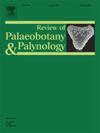Environmental drivers of fungal non-pollen palynomorphs in European temperate forest
IF 1.7
3区 地球科学
Q2 PALEONTOLOGY
引用次数: 0
Abstract
Fungal non-pollen palynomorphs (fNPPs) are increasingly recognized as valuable indicators in paleoecology, yet their ecological preferences in temperate lowland forests remain poorly understood. This study examines the environmental drivers shaping fNPP assemblages by assessing their relationships with key ecological gradients: forest type, ungulate pressure, canopy openness, and deadwood characteristics (coarse woody debris, snags, and stumps). Understanding these associations is critical for refining the use of fNPPs as indicators of forest structure, disturbance regimes, and ecosystem dynamics.
We analyzed fNPP assemblages from moss samples collected across structurally diverse forest habitats and applied multivariate analyses to determine their ecological affinities. The results indicate that medium ungulate pressure and variations in canopy openness significantly influence fungal community composition. Additionally, different types and volumes of deadwood provide key microhabitats for specialized fungal taxa, while saprotrophic and coprophilous fungi reflect organic matter decomposition and herbivore activity. Certain taxa also exhibited strong preferences for specific forest types, suggesting that fNPPs can indicate past moisture regimes, tree species composition, and forest dynamics.
These findings highlight the potential of fNPPs as proxies for past forest conditions, particularly in reconstructing herbivore activity, canopy structure, and wood decay processes. By linking modern fungal assemblages to environmental gradients, this study enhances the interpretation of fNPP records in paleoecology and provides a refined tool for reconstructing historical ecosystem processes and forest succession patterns.
欧洲温带森林真菌非花粉型的环境驱动因素
真菌非花粉孢粉形态(fNPPs)越来越被认为是古生态学中有价值的指标,但它们在温带低地森林中的生态偏好仍然知之甚少。本研究通过评估其与关键生态梯度(森林类型、有蹄类压力、树冠开度和枯木特征(粗木屑、障碍和树桩)的关系,探讨了形成fNPP组合的环境驱动因素。了解这些关联对于完善fnpp作为森林结构、干扰制度和生态系统动态指标的使用至关重要。我们分析了不同结构森林生境苔藓样品中的fNPP组合,并应用多变量分析来确定它们的生态亲和性。结果表明,中等有蹄类压力和冠层开度变化对真菌群落组成有显著影响。此外,不同类型和体积的枯木为特定真菌类群提供了关键的微生境,腐养型和腐养型真菌反映了有机质分解和草食活性。某些分类群还表现出对特定森林类型的强烈偏好,这表明fNPPs可以指示过去的湿度状况、树种组成和森林动态。这些发现突出了fnpp作为过去森林条件代表的潜力,特别是在重建草食动物活动、树冠结构和木材腐烂过程方面。通过将现代真菌组合与环境梯度联系起来,本研究增强了对古生态学中fNPP记录的解释,并为重建历史生态系统过程和森林演替模式提供了一种完善的工具。
本文章由计算机程序翻译,如有差异,请以英文原文为准。
求助全文
约1分钟内获得全文
求助全文
来源期刊
CiteScore
3.50
自引率
21.10%
发文量
149
审稿时长
6 months
期刊介绍:
The Review of Palaeobotany and Palynology is an international journal for articles in all fields of palaeobotany and palynology dealing with all groups, ranging from marine palynomorphs to higher land plants. Original contributions and comprehensive review papers should appeal to an international audience. Typical topics include but are not restricted to systematics, evolution, palaeobiology, palaeoecology, biostratigraphy, biochronology, palaeoclimatology, paleogeography, taphonomy, palaeoenvironmental reconstructions, vegetation history, and practical applications of palaeobotany and palynology, e.g. in coal and petroleum geology and archaeology. The journal especially encourages the publication of articles in which palaeobotany and palynology are applied for solving fundamental geological and biological problems as well as innovative and interdisciplinary approaches.

 求助内容:
求助内容: 应助结果提醒方式:
应助结果提醒方式:


